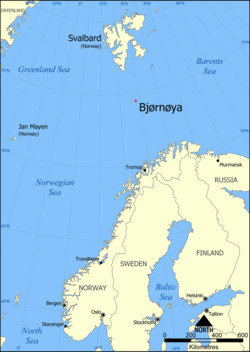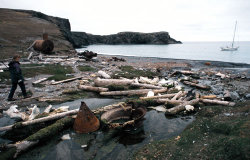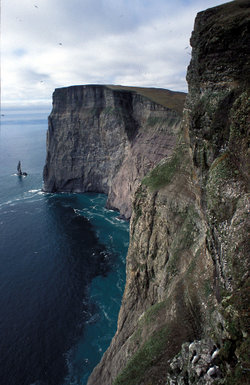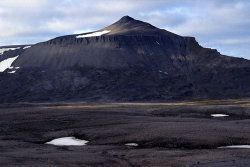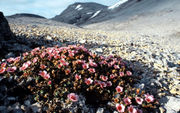Bjørnøya
2007 Schools Wikipedia Selection. Related subjects: European Geography
Bjørnøya ( IPA: [ˈbjøːɳøja]), meaning "Bear Island" in Norwegian, is an arctic island of Norway that forms the southernmost part of Svalbard. It is located in the western part of the Barents Sea at , approximately halfway between Spitsbergen and the North Cape. It was discovered by Willem Barents and Jacob van Heemskerk on 10 June 1596, and it was named when a polar bear was seen swimming nearby. Bjørnøya was considered terra nullius until the Svalbard Treaty of 1920 placed it under Norwegian sovereignty. Despite its remote location and barren nature, the island has seen some commercial activities in past centuries, such as coal mining, fishing and whaling. However, no settlements have lasted more than a few years, and Bjørnøya is now uninhabited with the exception of the meteorological station personnel. Along with the adjacent waters, it was declared a nature reserve in 2002.
History
Norwegian seafarers of the Viking era may have known Bjørnøya, but the documented history begins in 1596, when Willem Barents sighted the island on his third expedition . Further exploration was conducted in 1603 and 1605 by Steven Bennet, who noted the then rich population of walrus. Starting in the early 17th century, the island was used mainly as a base for the hunting of walrus and other seal species, as well as whaling. Eggs of seabirds were harvested from the large bird colonies until 1971.
There have never been extensive settlements on Bjørnøya. The remnants of a whaling station from the early 20th century can be seen at Kvalrossbukta ("walrus bay") in the southeast. A coal mine with a small settlement named Tunheim on the northeastern coast existed from 1916 to 1925, but mining was given up as unprofitable. Due to the cold and dry climate, the remains of the settlement (including a half-destroyed jetty and a steam locomotive) are relatively well preserved.
The strategic value of Bjørnøya was recognised in the late 19th century, when Imperial Russia and Imperial Germany demonstrated their interests in the Barents Sea. The German journalist Theodor Lerner visited Bjørnøya in 1898 and 1899, and claimed rights of ownership there. In 1899, the German fishery association Deutsche Seefischerei-Verein (DSV) started investigations of whaling and fishery in the Barents Sea. The DSV was secretely in contact with the German naval command and the possibility of an occupation of Bjørnøya was considered. In reaction to these advances, the Russian Navy sent out the protected cruiser Svetlana for an investigation, and the Russians hoisted their flag over Bjørnøya on 21 July 1899, leading to protests by Lerner. However, no violence occurred and the matter was settled diplomatically with no definitive claims of sovereignty over Bjørnøya by any nation.
The whole island was privately owned by the coal mining company Bjørnøen AS from 1918 to 1932, when the Norwegian state took over the shares. Bjørnøen AS now exists as a state owned company and is jointly managed with Kings Bay AS, the company that runs the operations of Ny-Ålesund on Spitsbergen. A Norwegian radio station (Bjørnøya Radio, callsign: LJB ) was established in Herwighamna on the north coast in 1919. It was later extended to include a meteorological station.
As the shipping routes from the Atlantic Ocean to Murmansk and the ports of the White Sea pass through the Barents Sea, the waters near Bjørnøya have been of great strategic importance in the Second World War as well as the Cold War. Although Svalbard was not occupied by Germany in the Second World War, German forces erected several weather stations there. An automated radio station was deployed on Bjørnøya in 1941. German forces attacked several arctic convoys with military supplies for the Soviet Union in the waters surrounding Bjørnøya. They inflicted heavy losses upon Convoy PQ-17 in June/July 1942 but were ineffective in the Battle of the Barents Sea on New Year's Eve 1942. The waters southeast of Bjørnøya were the scene of more naval battles in 1943. In November 1944, the Soviet Union proposed to annul the Svalbard Treaty with the intention of gaining sovereignty over Bjørnøya. Negotiations with Trygve Lie of the Norwegian government-in-exile had however not lead to an agreement by the end of the Second World War and the Soviet proposals were never implemented . The Soviet Union (and later, Russia) maintained their presence on Spitsbergen, however.
In 2002 a nature reserve was established that covers all of the island, except 1.2 km² around the meteorological station; the reserve also includes the adjacent waters to four nautical miles (7.4 km) from the coast . Today, the only population on the island (approximately ten persons) is the staff of the Norwegian meteorological and radio station at Herwighamna. The station conducts meteorological observations and provides logistic and telecommunication services. It also maintains a landing place for use by helicopters of the Norwegian Coast Guard. The Norwegian Polar Institute conducts annual expeditions to Bjørnøya, mostly concerned with ornithological research. Several other research projects, mostly pertaining to geography and climatology, are carried out less regularly. There are very few opportunities for individual travel to Bjørnøya. A few yachts make landfall, usually en route between the Norwegian mainland and Spitsbergen. A small number of cruising ships have visited the island, but tourism is otherwise almost nonexistent.
Hydrography, geography and climate
Hydrographic surveys of the waters of Svalbard have been conducted by agencies of the Norwegian government throughout the 20th century, namely by "Norges Svalbard- og Ishavsundersøkelser" since 1928, its successor, the Norwegian Polar Institute since 1948, and the Norwegian Hydrographic Service since 1984 . Land surveying and mapping falls in the responsibility of the Polar Institute.
Bjørnøya lies in the westernmost part of the Barents Sea on Spitsbergen Bank which extends southward from Spitsbergen and Edgeøya, forming a part of the continental shelf. Water depths near the island and to the north and east do not much exceed 100 metres, but become much greater to the south, and especially some thirty nautical miles to the west, where the continental shelf slopes into the deep water of the Norwegian Sea and Greenland Sea.
The island's outline is an irregular triangle pointing south with a greatest north-south extension of 20 km and a greatest east-west extension of 15.5 km; its surface area is 178 km². The southern part of Bjørnøya is mountainous, the highest top being Miseryfjellet on the southeast coast at about 536 metres above sea level. Other notable mountains are Antarcticfjellet in the southeast, and Fuglefjellet, Hamburgfjellet, and Alfredfjellet in the southwest. The northern part of the island forms a lowland plain that comprises some two thirds of the surface area. The lowland is strewn with shallow freshwater lakes which cover some 19 km² in all. Several streams flow into the sea, often as waterfalls in the steeper parts of the coast. There are no glaciers on Bjørnøya.
The coast is mostly steep with high cliffs and notable signs of erosion, such as caverns and isolated rock pillars. There are also a few sandy beaches. A number of anchorages and landing points exist, as well as a small harbour at Herwighamna on the north coast. However, none of these are safe in all weather conditions and a ship mooring anywhere on Bjørnøya must therefore be prepared to weigh anchor at any time.
A branch of the North Atlantic current carries warm water to Svalbard, creating a climate much warmer than that of other regions at similar latitude. Bjørnøya's climate is maritime- polar with relatively mild temperatures during the winter. January is the coldest month, with a mean temperature of −8.1 °C (base period 1961–1990). July and August are the warmest months, with mean temperatures of 4.4°C. There is not much precipitation, with an average of 371 mm per year in the northern lowland area. The weather can be quite stable during the summer months although fog is common, with a maximum at 20% of all days in July; it develops when warm air from of Atlantic origin passes over cold water.
A boundary between cold water of polar origin and warmer, Atlantic water exists in the western part of the Barents Sea. Thus, the water temperature can be quite variable within a few dozen nautical miles of Bjørnøya, sometimes reaching 10°C in summer. During the winter there is fast ice on the coast, but very rarely on the open sea around Bjørnøya. Pack ice is carried to Bjørnøya from the Barents Sea in every winter, sometimes as early as October, but a significant amount of ice is not common before February.
The polar night lasts from 8 November to 3 February, and the period of midnight sun from 2 May until 11 August.
Flora and fauna
There is little plant growth, consisting mostly of moss and some scurvy grass, but no trees. Despite its name, Bjørnøya is not a permanent residence of polar bears although many arrive with the expanding pack ice in the winter. Occasionally, a bear will stay behind when the ice retreats in spring and stay over the summer months . There are also a few arctic foxes but no other indigenous land mammals. Ringed Seal and Bearded Seal live in the waters near Bjørnøya, but the formerly common walrus has nowadays become a rare guest. The only land birds are the snow bunting and ptarmigan, but the island is very rich in guillemot, puffin, fulmar, kittiwake, glaucous gull and other seabirds that inhabit the vast cliffs in the south. The pink-footed goose and other species visit Bjørnøya during their seasonal migration between Svalbard's northern islands and mainland Europe. Bjørnøya's freshwater lakes are home to a population of arctic char.
Environmental problems
Although there are currently no industrial activities on Bjørnøya or in its immediate vicinity, pollution by toxic and radioactive substances remains a threat to the island's virtually untouched nature. Exploration in the Barents sea and the recent development of the Snøhvit gas field off the northern coast of Norway shows that the ecologically sensitive polar and subpolar sea areas of the Norwegian and Barents Sea have come into the focus of the petrol and gas industry . The environmental organisation Bellona has criticised the Norwegian government for licensing these activities without sufficient studies of their ecological impact. Organic toxins, specifically PCBs, have been found in high concentrations in biological samples from Bjørnøya, especially in arctic char of the freshwater lake Ellasjøen . The Soviet submarine K-278 Komsomolets sank on 7 April 1989 some 100 nautical miles southwest of Bjørnøya . Leakage of radioactive material from the reactor and nuclear warheads currently poses a minor problem, but severe pollution of the surrounding waters remains possible .
